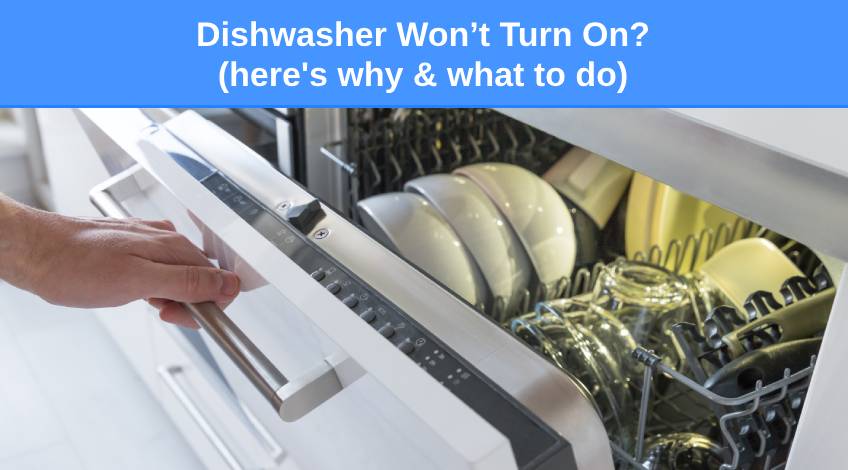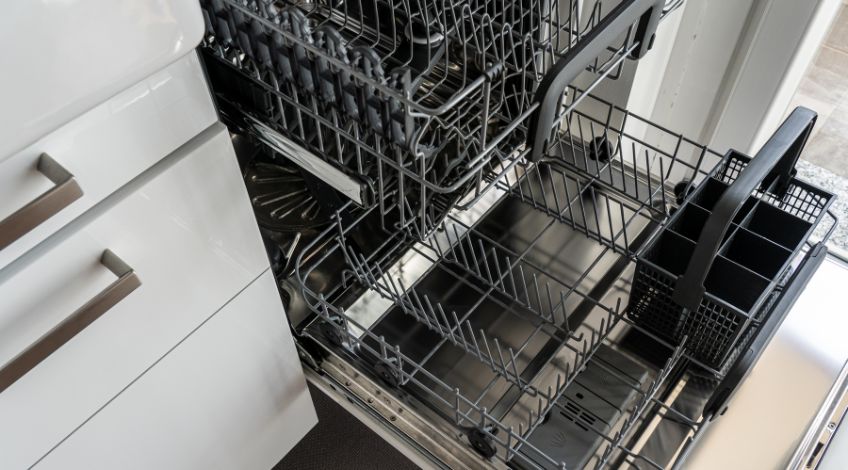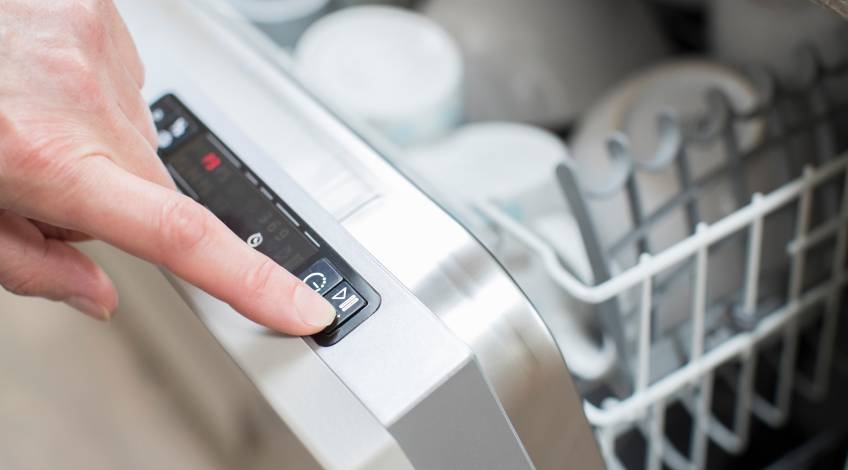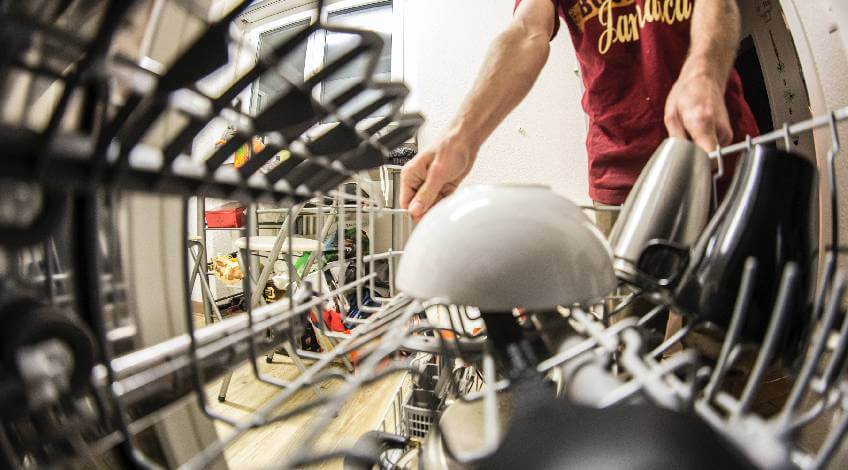
Dishwasher Won’t Turn On? (here’s why & what to do)
If your dishwasher won’t turn on it can seem disastrous, especially if it’s full of dirty dishes that you’re waiting to use. You might be thinking that you’re going to need to contact a technician to fix it for you.
However, whilst there are some instances when getting the dishwasher to work again might require an expert, there are lots of checks you can do first. Which might result in a simple fix that gets your dishwasher up and running in no time (and at no expense).
In this article we look at all of the potential reasons why your dishwasher won’t turn on and explain the best ways to solve these issues.
Why Won’t The Dishwasher Turn On?

Please Note: You should never dismantle any part of your dishwasher without disconnecting the appliance from the power supply first.
There are several reasons why the dishwasher might not turn on including;
No Power
If the dishwasher won’t do anything at all, it could be because it’s not getting any power. This could be because the circuit breaker has tripped, the plug has become disconnected from the wall socket or there has been a power outage.
Check that your home has power and once that’s been established, check the circuit breaker by switching it off and then on again. Check that the wall plug is pushed fully into the socket and check that the socket works by plugging something else into it and see if that works.
You should also check to see if the fuse has blown in the plug. If you’re sure there’s no issue with the power supply at all, move on to the next step.
Child Lock Engaged
Almost all modern dishwashers have a child lock which is a safety device designed to prevent inquisitive little hands from opening the dishwasher or changing the settings.
The dishwasher will not start if the child lock is engaged. You will need to deactivate the child lock to get the appliance working again.
This usually involves pressing and holding the child lock button for 3 to 5 seconds. Yours might be different so consult your user manual for more detailed information.
Defective Door Latch
There is a sensor on the door latch that notifies the control board once the door is fully closed. If the door isn’t closed properly, the dishwasher won’t start.
You can check this by opening the door and then closing it again. As you close the door, listen for the latch, you should hear it clicking into place.
If you suspect the door latch is the cause of the problem, it will need to be replaced. This can be done by a competent DIYer or you could contact a technician to do this for you.
If you decide to do this yourself, you will need to test it for continuity using a multimeter set to Rx1. Touch the probes to the latch terminals, if the latch is OK you should get a reading of zero or thereabouts, any higher and the door latch will need replacing.
Interrupted Cycle
If the wash cycle has been interrupted for some reason, it can cause the cycle to get stuck. In some cases you will see some sort of error code or there will be a light or two flashing. However sometimes there’s no indication and the machine just stops working.
If you suspect that the cycle has been interrupted, you can often reset it simply by disconnecting it from the power supply for 10 to 15 minutes.
Once the appliance has been reset, you can usually restart the wash cycle.
Defective Timer
The timer on a dishwasher controls the duration of the wash cycle. Typically found on the control panel or behind the lower kickplate. If you are confident in your abilities you can check the timer for continuity by setting the multimeter to Rx1000.
Touch the probes to the timer’s contacts and check the reading. It should read somewhere between 2000 to 3500 ohms. If you get readings significantly different to this, you will need to replace the timer.
Faulty Selector Switch

Selector switches are used to determine the wash cycle settings for each cycle. Typically found on the control panel, you can test each selector using a multimeter. Set the multimeter to Rx1 and touch the probes to the terminals on each switch.
Press the button on the multimeter which should alter the readings to zero. If you get a different reading, the selector in question needs to be replaced.
Defective Motor Start Relay
The motor start relay sends a signal to the motor to get it to start. If it develops a fault, it will fail to start the motor.
You can access the motor start relay by removing the lower access panel. However, this can be difficult to access which is why we recommend getting a technician to check this for you.
Blown Thermal Fuse
The thermal fuse is a safety feature designed to prevent any of the electrical components on the dishwasher from overheating. If the thermal fuse blows, it will shut down the dishwasher.
You can check the thermal fuse using a multimeter set to Rx1. The thermal fuse is typically located on the control board behind the inner door. To check it, you’ll need to remove the connecting wires to remove the fuse from the panel.
Touch the two probes onto the contacts on the fuse, if you get a reading above zero, the thermal fuse will need to be replaced.
Defective Drive Motor
The drive motor powers the pump that moves water around the dishwasher. If the drive motor is defective, you might notice that the dishes don’t clean properly or the appliance might not start at all.
This is another part we recommend getting an expert to check for you. The technician will be able to advise you on whether it’s worth replacing the drive motor or buying a new dishwasher.
This is because drive motors are typically quite expensive, so depending on the age of your appliance it might work out better financially to buy a new appliance. Especially if your existing model is more than 5 or 6 years old.
Part Replacements

You will need the model number of your dishwasher to ensure you find the correct replacement parts. Many manufacturers use universal parts, there are some that will only work if you use brand specific parts.
You can often find all of the information you need in your user manual or by contacting the company directly.
SEE ALSO: Dishwasher Salt Alternatives (what you can use instead)
Frequently Asked Questions
If your dishwasher suddenly won’t turn on it could be because; there’s no power, the door latch is defective, the child lock is activated, the timer is defective, the thermal fuse has blown, the motor start relay is faulty or the drive motor is defective.
To reset a dishwasher that won’t start you should disconnect the power supply for 10 to 15 minutes. Once the power is reinstated, the appliance should work as normal.
Dishwashers don’t typically have reset buttons. To reset a dishwasher all you need to do is disconnect it from the power supply for 10 to 15 minutes.
Also, follow us on Pinterest ...



